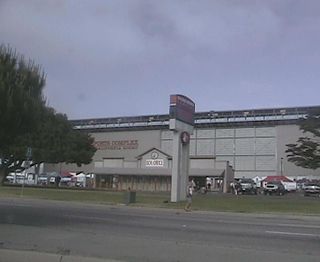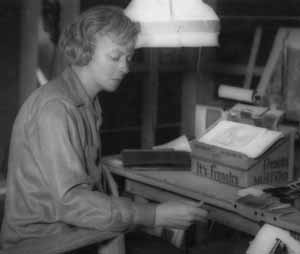
Manzanar is the site of one of ten American concentration camps, where more than 120,000 Japanese Americans were incarcerated during World War II from March 1942 to November 1945. Although it had over 10,000 inmates at its peak, it was one of the smaller internment camps. It is located at the foot of the Sierra Nevada mountains in California's Owens Valley, between the towns of Lone Pine to the south and Independence to the north, approximately 230 miles (370 km) north of Los Angeles. Manzanar means "apple orchard" in Spanish. The Manzanar National Historic Site, which preserves and interprets the legacy of Japanese American incarceration in the United States, was identified by the United States National Park Service as the best-preserved of the ten former camp sites.

During World War II, the United States, by order of President Franklin D. Roosevelt, forcibly relocated and incarcerated at least 125,284 people of Japanese descent in 75 identified incarceration sites. Most lived on the Pacific Coast, in concentration camps in the western interior of the country. Approximately two-thirds of the inmates were United States citizens. These actions were initiated by Executive Order 9066 following Imperial Japan's attack on Pearl Harbor. Like many Americans at the time, the architects of the removal policy failed to distinguish between Japanese immigrants and Japanese Americans. Of the 127,000 Japanese Americans who were living in the continental United States at the time of the Pearl Harbor attack, 112,000 resided on the West Coast. About 80,000 were Nisei and Sansei. The rest were Issei immigrants born in Japan who were ineligible for U.S. citizenship under U.S. law.

Camp Harmony is the unofficial euphemistic name of the Puyallup Assembly Center, a temporary facility within the system of internment camps set up for Japanese Americans during World War II. Approximately 7,390 Americans of Japanese descent from Western Washington and Alaska were sent to the camp before being transferred to the War Relocation Authority camps at Minidoka, Idaho, Tule Lake, California and Heart Mountain, Wyoming.

The Fairplex has been the home of the L.A. County Fair since 1922. Known prior to 1984 as the Los Angeles County Fairgrounds, it is located in the city of Pomona, California. The L.A. County Fair is held during the month of May since 2022, but the facility is used year-round to host a variety of educational, commercial, and entertainment such as trade and consumer shows, conventions, and sporting events.

Pinedale is a previously unincorporated community in Fresno County, California. It lies at an elevation of 348 feet. It was once a rural community located on the Southern Pacific Railroad 3.5 miles (5.6 km) north-northwest of Clovis but has since become surrounded and annexed by the city of Fresno. Millerton Lake State Recreational Area is to its NE. The ZIP Code is 93650, and the community is inside area code 559.

The Salinas Sports Complex is a sporting complex located in Salinas, California on the Central Coast. The main feature of the complex is a 17,000-seat stadium for California Rodeo Salinas. Soccer, football, and rugby was also played at the main stadium before the opening of Rabobank Stadium next door.

The Big Fresno Fair, founded in 1884, is an annual fair held at the Fresno County Fairgrounds. The Big Fresno Fair is managed by the 21st District Agricultural Association, an entity of the California Department of Food and Agriculture Division of Fairs & Expositions. It is the largest annual event in the San Joaquin Valley, attracting around 600,000 people each October during its twelve-day run featuring exhibits, a livestock show, live horse racing, musical entertainment, educational programs and more. The Fair provides a link between urban and rural California, serving as a tool to educate visitors on the region's rich agricultural industry. The mission of The Big Fresno Fair is to "Educate, Celebrate and Have Fun".

Arboga is an unincorporated community in Yuba County, California. It is located 3 miles (4.8 km), south of Olivehurst on the Sacramento Northern Railroad, at an elevation of 56 feet. It was named in 1911 by the pastor of the Mission Covenant Church of Sweden for his hometown of Arboga, Sweden.
Togo W. Tanaka was an American newspaper journalist and editor who reported on the difficult conditions in the Manzanar camp, where he was one of 110,000 Japanese Americans who had been relocated after the Japanese attack on Pearl Harbor on December 7, 1941.

The Tanforan Assembly Center was created to temporarily detain nearly 8,000 Japanese Americans, mostly from the San Francisco Bay Area, under the auspices of Executive Order 9066. After the order was signed in February 1942, the Wartime Civil Control Administration acquired Tanforan Racetrack on April 4 for use as a temporary assembly center; plans called for the site to be used to accommodate up to 10,000 "evacuees" while permanent relocation sites were being prepared further inland. The Tanforan Assembly Center began operation in late April 1942, the first stop for thousands who were forced to relocate and undergo internment during World War II. The majority were U.S. citizens of Japanese ancestry who were born in the United States. Tanforan Assembly Center was operated for slightly less than six months; most detainees at Tanforan were transferred to the Topaz War Relocation Center in Utah, starting in September. The transfer to Topaz was completed by mid-October, and the site was turned over to the Army a few weeks later.

The Manzanar Children's Village was an orphanage for children of Japanese ancestry incarcerated during World War II as a result of Executive Order 9066, under which President Franklin D. Roosevelt authorized the forced removal of Japanese Americans from the West Coast of the United States. Contained within the Manzanar concentration camp in Owens Valley, California, it held a total of 101 orphans from June 1942 to September 1945.
Mitsuye "Maureen" Endo Tsutsumi was an American woman of Japanese descent who was placed in an internment camp during World War II. Endo filed a writ of habeas corpus that ultimately led to a United States Supreme Court ruling that the U.S. government could not continue to detain a citizen who was "concededly loyal" to the United States.

Estelle Ishigo, née Peck, was an American artist known for her watercolors, pencil and charcoal drawings, and sketches. During World War II she and her husband were incarcerated at the Heart Mountain Relocation Center in Wyoming. She subsequently wrote about her experiences in Lone Heart Mountain and was the subject of the Oscar winning documentary Days of Waiting: The Life & Art of Estelle Ishigo.
The Japanese American Evacuation and Resettlement Study (JERS) was a research project funded by the War Relocation Authority (WRA), an agency responsible for overseeing the relocation of Japanese Americans, The University of California, the Giannini Foundation, the Columbian Foundation, and the Rockefeller Foundation with the total amount of funding reaching almost 100,000 U.S. dollars. It was conducted by a team of social scientists at the University of California, Berkeley. The team was led by sociologist Dorothy Swaine Thomas, a Lecturer in Sociology for the Giannini Foundation and a professor of rural sociology, and included anthropologists John Collier Jr. and Alexander Leighton, among others. The study combined each of the major social sciences such as sociology, social anthropology, political science, social psychology, and economics to effectively illustrate the effects of internment on Japanese Americans. The terminology of "relocation" can be confusing: The WRA termed the forced removal of Japanese Americans from the West Coast an "evacuation" and called the incarceration of these people in the ten camps as "relocation." Later it also applied the term "relocation" to the program that enabled the evacuees to leave the camps (provided they had been certified as loyal.

The Temporary Detention Camp for Japanese Americans / Pomona Assembly Center is one of the places Japanese Americans were held during World War II. The Pomona Assembly Center was designated a California Historic Landmark on May 13, 1980. The Pomona Assembly Center is located in what is now called the Fairplex in Pomona, California in Los Angeles County. The Pomona Assembly Center was called Los Angeles County Fairgrounds in 1942.

The Santa Anita Ordnance Training Center also called Camp Santa Anita was training center built for World War II. Santa Anita Ordnance Training Center Rifle Range was built is what is now the foothills of the San Gabriel Mountains in the Angeles National Forest, just north of East Pasadena, California and Sierra Madre, California. The 1029 acres camp, opened on November 30, 1942, was used for rifle and pistol training. Also at the range was small anti-aircraft range and an infiltration course, a type of obstacle course. The range closed in 1944 and the land lease ended in 1950. Most of troops trained at the range were based at the U.S. Army Ordnance Corps's Santa Anita Ordnance Training Center at the Santa Anita Racetrack in Arcadia, California in Los Angeles County. Before used as a training center the Santa Anita Racetrack was used for the Santa Anita assembly center a temporary internment camp for Japanese Americans from March 27 to October 27 of 1942. Camp Santa Anita was also used to hold German prisoner of war, held at the camp was several thousand of Erwin Rommel's Afrika Korps troops captured during the North African campaign. The Center had some Italian Service Units working at the depot.

The Merced County Fairgrounds are home to the annual Merced County Fair, the county fair of Merced County, California. The Merced County Fair was first held on September 2, 1891. The first fair was held on 18th Street in Merced and was a joint county fair with neighboring Mariposa County. The Merced County Fair showcases livestock, exhibits, carnival rides, music and fair food each year.
The Merced Assembly Center, located in Merced, California, was one of sixteen temporary assembly centers hastily constructed in the wake of Executive Order 9066 to incarcerate those of Japanese ancestry beginning in the spring of 1942, following the attack on Pearl Harbor and prior to the construction of more permanent concentration camps to house those forcibly removed from the West Coast. The Merced Assembly Center was located at the Merced County Fairgrounds and operated for 133 days, from May 6, 1942 to September 15, 1942, with a peak population of 4,508. 4,669 Japanese Americans were ultimately incarcerated at the Merced Assembly Center.
Harry Yoshio Ueno was a Japanese-American union leader who was interned in Manzanar Concentration Camp. He rose to prominence when he was arrested and removed from the camp after being accused of attacking the leader of the Japanese American Citizens League on the night of December 5, 1942. His arrest sparked a series of protests among his fellow detainees in the camp which turned into the Manzanar Riot.


















